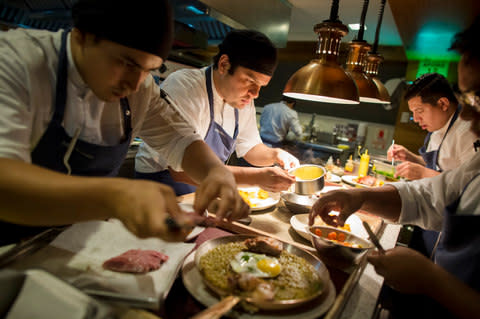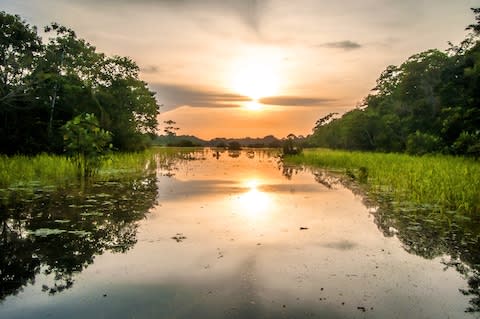How Lima shed its dangerous reputation to become South America's greatest city for food

I’d never have thought cows’ hearts could look so appetising. The meat was rich, textured like tongue and a bit chewy. The overboiled spuds reminded me of childhood Sunday dinners. The glass of chicha morada, a purple corn beverage, was comforting, like cough mixture. The venue, El Tio Mario – Uncle Mario’s – was an upmarket canteen, functional, family oriented, the décor just a bit too orange.
In fact, anticuchos – cows’ hearts – are a classic of Peruvian cuisine, and have their aficionados. But my delight was contrastive. Following a week in Lima I was midriff-swellingly sated on fine dining. After a glut of refined, sometimes rarefied, lunches and dinners, a plate of offal was both comfort food and penance.
Peru’s capital, once spurned as South America’s least safe, most run-down city – a hurried stopover en route to Cuzco and Machu Picchu – has reinvented itself as a global gastronomy destination. Everyone knows about ceviche, quinoa and pisco. Peruvian eateries have opened in Manchester and Newcastle. London’s Lima restaurant has a Michelin star. But, despite regular visits to Peru over 15 years, nobody had ever explained to me how Lima came to love its cuisine.
Most agree that the man who got the whole thing going was Gastón Acurio, who I met at his restaurant, Astrid y Gastón, in the residential district of San Isidro.
“Lima is a triumph of love,” he said. “A miracle took place here because, in spite of all our differences, we’ve shown we can produce beautiful things together. I wanted to show off a multiculturalism without limits. Peruvians are Andean, African and European, and we eat everything from Nikkei [Japanese diaspora] food to Cantonese food to Genovese food. That’s the essence of this city and we need to celebrate it.”

Acurio praised the generation of chefs who came before him as “true pioneers”. Names like Isabel Álvarez, Teresa Izquierdo and Bernardo Roca Rey won’t mean much to British ears, but in Peru they are legends.
“Still, when I came back from Paris in the Nineties, I had to serve French food,” recalled Acurio.
“I had friends who served quinoa at their restaurants, but they were empty. It was only when I began to travel with Astrid [his German wife] that I began to rediscover Peru and the fact that we have thousands of years of art, architecture, design – and food!”
Afterwards, I stayed for lunch. The tasting menu was outstanding, featuring mouthwatering, bite-sized gnocchi and scallops with a reduction made from a tropical fruit called lucuma, suckling pig confit in pibil and black bean sauces and guinea pigs in a purple-corn crepe. Guinea pig is often mentioned as a sort of sly joke when talking about Andean cuisine, but the meat is actually protein-rich, low in fat, and exceedingly moreish. Acurio’s wizardry would count for little if it weren’t for the quality of Peruvian produce.

I spent a couple of mornings exploring Lima’s food markets. At a small local market in Barranco I admired huge grouper fish, tropical fruits too exotic to have translations – cocona, noni, pitahaya – and checked out the latest Andean grains. Quinoa and amaranth? They’re so last year. Soon you’ll be trying camu camu and maca. In the huge Surquillos market I wandered slowly past a dizzying array of fresh and packaged produce, from imported Venezuelan arepa flours to llama jerky to fresh herbs and hallucinogenic San Pedro cactus stalks.
Why this abundance? María Julia Raffo – who does a shopping and eating tour called Urban Eats – explained: “It’s all down to Pachamama, or mother nature. From the sea, we’ve the ecosystem of the cold Humboldt current, which gives us all the amazing fish and seafood. On dry land, we have coastal deserts, ultra-fertile Andean valleys, high plains and Amazon jungle, which have a huge range of climates and give us our massive larder of ingredients.”

Peruvian chefs have responded to this variety with dazzling displays of creativity. At Central – ranked on the influential San Pellegrino list as the best restaurant in Lima and fourth best in the world – I had a 17-course tasting menu themed around alturas or “elevations”. Chef Virgilio Martínez and his busy team of understudies deliver an array of intensely flavoursome dishes inspired by produce sourced from sea level to mountain summit, including limpets, river snails, seaweed, yacon, oca tubers, cacao, chicken and clay.
A post shared by Central (@centralrest) on Jan 10, 2017 at 10:50am PST
“Using food from all the different elevations is my way of celebrating the variety,” said Martínez. “When I travelled to the interior, I started to see the country vertically, not horizontally. The menu is also honouring a culture – all those agricultural workers who manage the different ecosystems.”
Japanese-Peruvian restaurant Maido’s theme was “200 miles”, referring to a stretch of Peru’s Pacific coast. Here, over a mere 13 courses, I ate a parody of a humble sausage sandwich (the sausage made from octopus), watched waiter-cum-engineers perform infusions of greens using what looked like a V60 coffee dripper, and had a fruity ice cream crafted to resemble a mussel.

But man cannot live on gourmet food alone and, after two days of intense gourmandising, I decided to check out Lima’s other booming cultural sector: art.
Callao Monumental is a project that aims to revive the fortunes of the district around South America’s oldest port (famously pillaged by Francis Drake in 1579). The venture is sponsored by businessman Gil Shavit, who donated an office block that now – rebranded as Fugaz – houses studios, galleries and places to eat and drink.
At street level, the art is spreading fast. Graffiti painters have enlivened the plazas and alleyways, and former gang members are employed as gallery guides. Lucuma, who sells political pop art from a hole in the wall behind Fugaz, told me that art keeps him clean. “I tried coke, paste, heroin, everything! I was in prison for 32 years. Our leaders want to censor me – but I just keep painting!”
In edgy Callao, there was still good food. At Mateo, a huarique – hard to translate but meaning something like “cheap and cheerful” – served swordfish steak with a hearty bean mash called tacu tacu. The clientele were clerical workers from the docks. You don’t need to go fancy to eat well in Lima.

In trendy Barranco, I saw a different side of Peruvian art at MATE, the recently expanded private gallery owned by photographer Mario Testino. Slick blow-ups of models, actors and friends tell the story of Testino’s magazine work. Another room contains the now famous black-and-white portraits of Princess Diana from her last shoot. A third exhibition presents striking glossy-style photographs of Andeans in splendid native costumes.
Callao and MATE. Central and Mateo. Glamour and grit. Lima is diverse, frenetic, evolving; increasingly, it makes Buenos Aires and Rio look tired and oversold.
Everyone agrees that food has been the main motor for change, making Limeños love their city and impressing foreigners, who now extend their stopovers to two or three days, even a week. But the chefs have social ambitions too. When I suggested to Gastón Acurio that he should be very satisfied with all he had achieved, his reply was firm.
“Not at all. Those of us who joined forces to change gastronomy dreamed about equality and social justice, for fishermen, farmers and for young people. The private sector made gastronomy famous. Now the Government has to do its bit. We need to tackle bad diets, obesity, hunger, education, environmental issues. We need to bring order about in the way that we manage the sea, the port, fishing, just as we have done in our restaurants.”
Virgilio Martínez agrees. “Food has become a way of fortifying our social identity. It’s a tool to bring us all together – whatever our origins – and grow as a society. We’ve really only just begun.”
How to get there
British Airways (britishairways.com) flies nonstop London Gatwick to Lima, from £654.22 return, including taxes/fees/carrier charges.
Aracari (0051 1651 2424; aracari.com) offers a five-day culinary trip to Lima from £1,770 per person. The price includes accommodation at the new Atemporal hotel and Hotel B, transfers, excursions with private guides, food-sampling tours, market visits, cooking lessons with a private chef, and reservations at three San Pellegrino Top 50 restaurants. Flights cost extra.
Lima's best restaurants
Astrid y Gastón
In a dreamy colonial mansion, Gastón Acurio’s flagship serves delectable duck and crab starters and zingy ceviches in the minimally decorated dining room. Ave Paz Soldán 290, San Isidro (0051 1 442 2777; astridygaston.com).
Central
Low-key décor focuses all eyes on the busy open kitchen, which turns out stunning constructions, emulsions and concoctions using local produce sourced at 17 altitudes from 20m below to 4,100m above sea level. Tasting menu £75. Santa Isabel 376, Miraflores (0051 1 1242 8515; centralrestaurante.com.pe).
Maido
Chef Mitsuharu Tsumura serves exquisite Japanese-Peruvian fusion food in a stylish modernist space. 13-course tasting menu £94. San Martín 399, Miraflores (0051 1 446 2512; maido.pe).

Huaca Pucllana
Enjoy sublime ceviches and sea bass chupes (stews) while looking out on to a 1,500-year-old adobe and old clay pyramid. Gral Borgoño Cdr 8, Miraflores (0051 1 445 4042; resthuacapucllana.com).
Mateo
Homely fish and steak in a friendly huarique. Lunch from £10. Jr Miller 286, El Callao (0051 1 465 2056; cevicheriamateo.com).
La Preferida
Tiny canteen founded in 1956 by Yugoslav immigrants specialising in tapas. Arias Aragues 698, Miraflores (0051 1 445 5180).
El Pan de la Chola
After decades of disregarding coffee – despite growing the stuff – Peru is now taking it seriously. Av Mariscal La Mar 818, Miraflores (0051 1 221 2138).
El Tio Mario
Anticuchos (chicken, beef and cows’ hearts kebabs), causas (potato salad) and other Peruvian classics in a restaurant that started life as a food trolley. Jr Zepita 214, Barranco (0051 1 477 0301; anticucheriatiomario.com).


